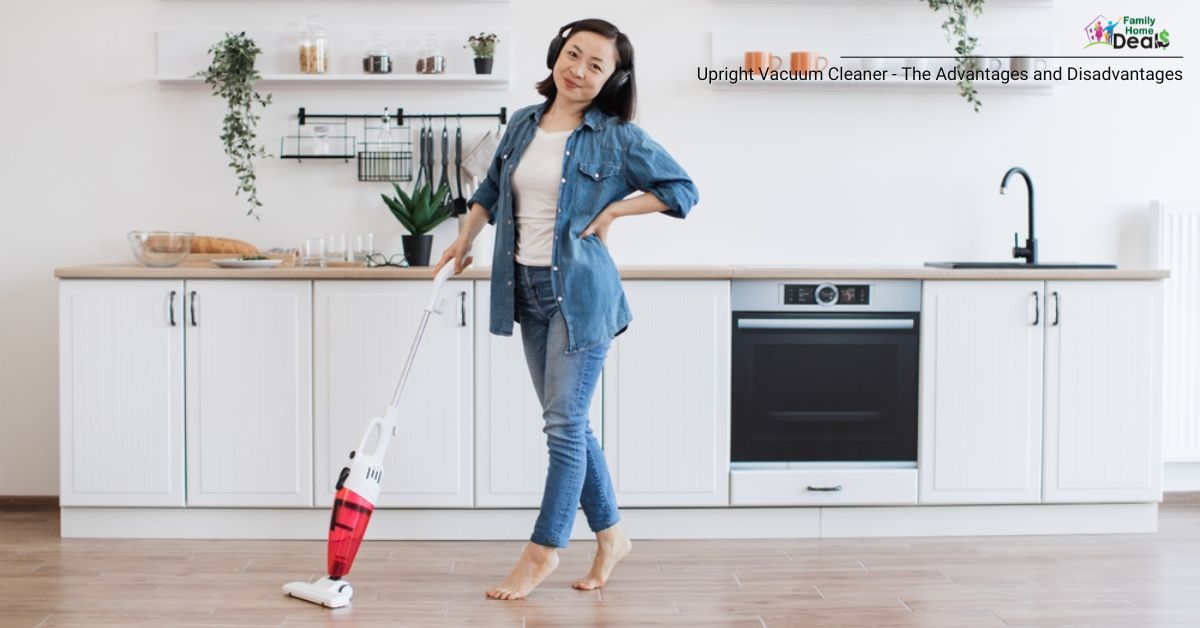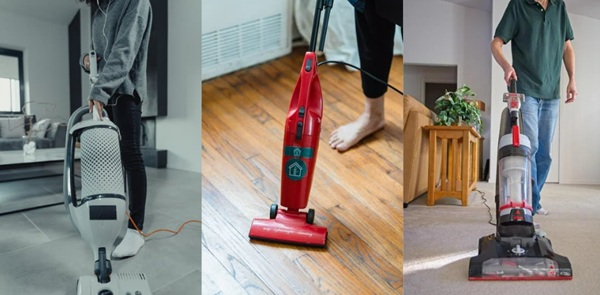
If you’re in the market for a new vacuum cleaner, the upright model is often among the first options that pop up — and for good reason. Upright vacuums are familiar, powerful, and generally built to handle large carpeted areas. But with newer designs, smart features, and changing flooring trends (think eco-friendly materials, mixed surfaces, pet sheds), it’s worth re‐examining their strengths and limitations now, not just for what they’ve always done.
In this article, we’ll dive deeply into what makes upright vacuum cleaners great, where they struggle, and what to look for to get the best model for your home in 2025. I’ll also include tips, example models, and practical advice so you don’t just end up with an appliance—you end up with one that feels “just right.” Let’s get sweeping!
What Exactly Is an Upright Vacuum Cleaner?
First, a quick refresh. An upright vacuum is a form factor where the motor, collection bin or bag, and cleaning head are all part of a single unit that stands upright. You push or pull it while standing, moving the whole body back and forth across the floor.

Key typical features:
-
Rotating brush roll (agitation) underneath to beat carpet fibers.
-
Larger cleaning head width compared to many canisters or handhelds.
-
Usually bagged or bagless collection—dust goes into a bag or chamber integrated into the upright unit.
-
Corded or cordless versions; some with battery packs now offering comparable runtime to corded versions.
What’s Changed in Uprights in 2025
Before jumping into pros and cons, you should know what’s new in upright vacuums this year—because innovations can change the calculus:
-
Cordless uprights have become much better: batteries with higher capacity (often lithium-ion), fast charging, and sometimes removable battery packs. You’ll see 40-60 minute run times on lighter settings.
-
Smart sensors & auto-adjustment: Many models now detect floor type and adjust suction power or brush roll speed automatically.
-
Better filtration: HEPA filters are standard or optional in many models. For allergy sufferers, this is a big plus.
-
Lighter materials: Use of carbon fiber reinforcements, lighter plastics, better ergonomics means you can get an upright under 8-10 kg that still packs power.
-
Noise reduction: Manufacturers are more attentive to keeping decibel levels lower, with sound‐dampening chambers, insulated motors, and quieter brush rolls.
These changes mean many of the classic “downsides” are less severe—or can be mitigated.
Advantages of Upright Vacuum Cleaners
Here are the major benefits of choosing an upright vacuum in 2025, bolstered with examples and actionable tips:
-
Power and Deep Cleaning on Carpets
-
The rotating agitator brush really works into carpet fibers, dislodging dirt more effectively than many stick or handheld models.
-
For homes with thick pile carpets, multi-layer rugs, or heavily soiled carpeted areas (e.g., stairs, pet zones), uprights often outperform others.
-
-
Wide Cleaning Path & Coverage
-
Uprights generally have wider cleaning heads—so you cover more floor area per pass. Great for large rooms or open plan living spaces.
-
Less time & effort compared to moving and adjusting smaller units manually.
-
-
Integrated Design: Less Bending Down
-
Handle positions and the upright posture mean less bending or stooping—easier on the back.
-
Some models have switches or levers on the handle (or a foot lever) so you don’t need to bend over to transition functions like powering on/off or changing brush height.
-
-
Durability & Maintenance for Intensive Use
-
Many uprights are built for heavy usage—robust motors, stronger gears, larger dust capacities. If you have pets, children, or high foot traffic, this is useful.
-
Long-lasting models with spare parts (brush roll, filters) are more available now that the upright style remains popular.
-
-
Feature Rich: Tools, Filtration, Convenience
-
Many uprights now include attachments (crevice tools, upholstery brushes, pet hair tools) built into the body for easy access.
-
HEPA or comparable high filtration is widespread, which helps with allergy control and cleaner exhaust air.
-
Some have LED lights, on-board storage, adjustable suction, and auto shut-off to protect sensitive floors.
-
-
Energy & Cost Efficiency (Modern Models)
-
New motors are more efficient; battery uprights are more practical for energy savings if properly charged and used.
-
Bagless designs reduce the ongoing cost of bags, though filters still need maintenance.
-
-
Better Maneuverability Than Before
-
Although classics had stiff steering, newer designs offer swivel heads, improved wheels or castors, even powered wheels in some models, making moving furniture and cleaning tight corners easier.
-
Disadvantages of Upright Vacuum Cleaners
No product is perfect—here are the limitations of uprights, especially seen through a modern lens. Being aware helps you choose one that minimizes downsides.
-
Bulk & Weight
-
Even with lighter materials, uprights are often heavier than stick, handheld, or canister models—making stairs, tight corners, or carrying between floors harder.
-
Lifting to storage or over thresholds can still require physical effort.
-
-
Storage Footprint
-
Uprights take up more vertical and floor space. If you live in a small apartment, closet space may be tight.
-
Couching between wood floors and low furniture can be difficult due to height and brush clearance.
-
-
Maneuverability in Hard-to-Reach Areas
-
Edges, under low beds, tight corners: pis of vacuum design may leave you needing smaller tools.
-
The rigid build means it’s more difficult to navigate around obstacles compared to flexible hoses or smaller wand-type vacuums.
-
-
Surface Limitations
-
While excellent on carpets, some uprights may damage delicate or natural floors if the brush roll is too stiff or cannot be disengaged.
-
On hard flooring (link: tile, hardwood, laminate), an upright with high suction and an improper brush roll may scatter debris instead of collecting it cleanly.
-
-
Maintenance Needs
-
Brush rolls need regular cleaning—pet hair, threads, carpet fringe can wrap up.
-
Filters must be cleaned or replaced—bagless units require frequent emptying and filter maintenance to retain suction.
-
-
Cost Considerations
-
Upfront cost for a high-quality upright with premium features (cordless, HEPA, auto-adjustment) is higher than basic stick or handheld models.
-
If battery-powered, there’s the eventual cost of battery replacement.
-
Ongoing maintenance (brush roll, belts, filters) can add recurring expense if not considered upfront.
-
How to Decide if an Upright Vacuum Is Right for You (2025 Checklist)
Here are actionable tips (with an affirming checklist) to help you choose a model that minimizes the cons and maximizes the pros. Use these as filters during your decision process.
-
Assess Your Flooring Mix
-
How much carpet vs hard floor do you have? If mostly carpet, upright is a strong fit.
-
On a hard floor, ensure the model has a switchable brush or soft roller to avoid scratching or scattering debris.
-
-
Consider Home Size & Storage
-
Big house, large rooms → wide cleaning path helps. But vertical storage space must accommodate height.
-
Multi-floor home → weight becomes more of a concern. You may prefer a model with a detachable battery or a lighter build.
-
-
Evaluate Pets & Mess Types
-
Dogs, cats, or kids → high-traffic areas, fur and debris. Look for models with strong suction, anti-hair wrapping technology, and pet-specific tools.
-
Allergies: HEPA filter, sealed dust paths, easy emptying.
-
-
Power Source: Corded vs Cordless
-
Corded offers virtually unlimited run time and often stronger suction. But cords limit mobility.
-
Cordless: freedom of movement, but check battery life, charging time, and whether the battery is removable/replaceable. Battery technology improves every year—2025 sees better energy density.
-
-
Weight, Handle, Ergonomics
-
Try one if possible—how easy is it to tilt back, push, pull?
-
Look for swivel heads or powered wheels.
-
Handle height & grip comfort should match your height/arm length.
-
-
Filtration & Dust Capacity
-
A bigger bin or bag means fewer trips to empty—but may be bigger/heavier.
-
HEPA or high-efficiency filters help with dust and allergens; check the replacement cost for filters.
-
-
Noise Level & Energy Efficiency
-
Quieter models are more pleasant, especially in open homes or shared living. Check decibels in spec.
-
Check energy consumption, especially for corded models—if buying in a region with high electricity cost, this adds up.
-
-
Warranty & Spare Parts Support
-
Good brands offer a decent warranty on motor, battery, etc.
-
Brush rolls, filters, and belts should be easily available locally. It reduces downtime and makes maintenance cheaper..
-
Protect your smartphone better with TORRAS Cases.
Built for hands, hearts, and heavy-duty drops. Get TORRAS’s best-selling MagSafe cases with built-in stands—sleek, shock-proof, and made for every style. Available while stocks last, so grab yours before they’re gone. Don’t just protect your phone, show it off only at torraslife.com.
Example Models & What They Do Well (2025 Picks)
Here are ten upright vacuum cleaner models available in 2025, each suited to different needs. Think of them as case studies to help you see how specs map to real value.
| Model | Best For | Stand-Out Features |
|---|---|---|
| Shark Vertex Pro Upright (NZ900UK / US Version) | Homes with pets and mixed surfaces | Powerful suction; self-cleaning brush roll; detachable handheld mode; HEPA-grade sealed system—great for fur and dander. |
| Dyson V15 Detect Mastiff / Outsize Upright Hybrid | Large carpeted homes, users wanting hybrid flexibility | Large dustbin; laser detection for dust; switch-off brush for hardwood; cordless with strong battery life. |
| Miele Dynamic U1 Cat & Dog | Premium buyers who want durability and quiet operation | Classic build; excellent filtration (HEPA); adjustable height settings; quiet motor; long-life parts with great support. |
| Bissell CleanView Swivel Pet Upright | Budget-conscious pet owners | Affordable price point; scatter-free technology for hard floors; pet turbo eraser tool; lightweight design. |
| Hoover WindTunnel 3 High Performance | Deep carpet cleaning | Patented WindTunnel suction channels; multiple height adjustments; large dirt cup capacity; strong choice for homes with lots of carpet. |
| Sebo Automatic X7 | Users wanting long-lasting, professional-grade performance | German-engineered build; automatic brush height adjustment; hospital-grade filtration; excellent for allergy sufferers. |
| Kenmore Elite Crossover Max Upright | Families needing versatility across surfaces | Bagless design; dual-motor system; swivel steering; strong suction on both carpets and hardwood. |
| Eureka PowerSpeed Upright | Shoppers on a budget who still want reliability | Lightweight design; XL dust cup; multiple accessories; simple, effective suction for everyday cleaning. |
| Oreck Elevate Command | Seniors or anyone who needs a lightweight upright | Ultra-lightweight (under 10 lbs); powerful suction for size; slim profile; excellent for quick cleans and easy storage. |
| Sanitaire Tradition Upright SC679K | Commercial or heavy-duty use | Built for durability, a large-capacity shake-out bag; strong suction for large areas; reliable for schools, offices, or hotels. |
Tip: Once you identify two or three models that seem good fits, compare noise levels, filter/bag cost, battery warranty, and after-sales service in your region. These practical factors often make or break long-term satisfaction.
Balancing the Trade-Offs: When Upright Is Your Best Bet vs When Another Type Is Better
To help you decide, here are scenarios and which vacuum styles tend to shine:
| Your Scenario | Upright Vacuum Benefit | Alternative Might Be Better If… |
|---|---|---|
| Mostly carpeted home with few stairs | Upright gives a strong carpet clean, wide path | If many stairs or lofts, a lightweight cordless stick or a canister may ease movement. |
| Pet hair and allergens are an issue | Upright with HEPA and anti-hair brush helps a lot | Handhelds are good for upholstery and car; but don’t replace uprights for floor work. |
| Hard floors + rugs | Models with switch-off brush roll or soft rollers help protect surfaces | A stick vacuum with a gentle brush roll might be easier to store and use daily. |
| Tight budget, but need strong cleaning | Mid-range uprights may deliver more power per dollar than many premium sticks | If on a very tight budget or need handheld flexibility, a simpler stick or basic canister may suffice. |
| Small apartment or limited storage | “Slim” uprights, cordless ones with removable batteries, or hook-mounting might work | Stick vacuums often take up less room and are easier to stow vertically. |
Maintenance Tips to Get the Best Life from Your Upright
Owning an upright means regular care. Here are practical tips so performance stays high and you get your money’s worth:
-
Clean the brush roll regularly – Remove hair, threads, or carpet fibers. Many modern uprights have tool-free brush roll removal, which simplifies cleaning.
-
Check belt and motor drive – If your model uses a belt for the brush roll, inspect it for wear. Replace before it breaks to avoid motor strain.
-
Empty or replace dustbin/bags appropriately – Don’t wait until completely full; full bins reduce suction.
-
Change or clean filters on schedule – HEPA filters especially: follow manufacturer’s instructions, usually every 6–12 months.
-
Watch for blockages – Hoses, wand, brush area: blockages reduce airflow and stress the motor.
-
Store properly – Store upright vacuums in upright position; avoid leaning them where hoses may be kinked.
-
Battery care (for cordless models) – Use them regularly and avoid keeping the battery at minimal charge for too long. If removable, store in a moderate temperature (not freezing or too hot).
Latest Trends & What to Expect Next
Here are new or emerging developments in upright vacuum tech to keep an eye on:
-
Smart connectivity: Some uprights will integrate with home automation—monitor battery health, filter status, and cleaning history via app.
-
Lighted dust detection: UV or laser sensors to show where finer particles lie, especially on hard floors.
-
Sustainability push: Recyclable or replaceable plastic parts; less use of single-use bags; battery recycling programs.
-
Modular designs: Very soon, you’ll see more uprights where the “upright” portion can be detached into a stick or handheld for more flexibility.
Conclusion
Choosing an upright vacuum cleaner in 2025 means balancing, more than ever, raw cleaning power with smart usability. If your home has a lot of carpet (especially thick carpet), pets, or you dread vacuuming chore days, an upright with modern features—like HEPA filtration, auto adjusting, cordless battery power—is often the most efficient, long-term solution. For homes with mixed flooring, tight spaces, or many stairs, you’ll want to choose carefully: lighter-weight, switchable brush rolls, or even consider hybrids or sticks as supplemental tools.
Ultimately, the best upright for you aligns with your specific home layout, cleaning needs, storage constraints, and budget, not just for purchase but for upkeep. Use the checklists above, try to test models in person if you can, and consider both upfront and recurring costs. Get that right, and your vacuum won’t just clean—it’ll make cleaning easier.



